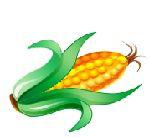Natural Solutions to Things That Bug You (87 page)
Read Natural Solutions to Things That Bug You Online
Authors: Myles Bader

Carrots do not break soil………………………………… Seedling pest
Roots hairy or misshapen……………………………….. Root knot nematode
Carrots curled around each other………………………. Planted too close together
Roots have surface tunnels with rusty excrement……. Carrot rust fly
White growth on leaves………………………………….. Powdery mildew

RADISHES TO THE RESCUE
Radishes have stronger sprouts and can break through the soil easier than carrot sprouts. If you plant radishes with the carrots they will break through the soil crust and allow the carrots to sprout more easily.
CAULIFLOWER
BROWN OUT
It is a common practice to tie the leaves up around a cauliflower plant as it grows to bleach the heads. Instead of the old method, try gathering up the leaves and then place a brown bag over the head. The air will still be able to circulate and will prevent rotting that is common when the leaves are tied.
COLE CROP PEST PROBLEM SOLVERS
(Broccoli, Brussels sprouts, Cabbage, Cauliflower)
THE PROBLEM CAUSED BY

Irregular holes in leaves, seedlings damaged………… Caterpillars
Small holes in leaves, stunted plant growth…………… Diamondback moth caterpillar
Deformed, curled leaves, gray-green insects
on leaves, possibly honeydew………………………….. Aphids
Plants wilted, with misshapen leaves, browning……… Harlequin bug
Tunnels through roots of seedlings, wilting……………. Cabbage maggot
Stunted plants, wilting, yellowish leaves………………. Cyst nematode
Heads split prematurely…………………………………. Heavy watering after dry spell
CHIVES
A WARM CHIVE IS A HEALTHY CHIVE
If you start seeds in the late summer and keep them inside where they can get adequate sun, you will have a nice supply of chives during the winter months.
CORN

DON’T HURT THOSE LITTLE SUCKERS
Corn suckers are the small shoots that grow out from the stalk at ground level. Many people remove them, but the latest research shows that they will not reduce yield and if there is a drought they will send nutrients to the main stalk. If you do remove them and don’t remove them properly you may cause diseases to enter the stalk.
CORN PEST PROBLEM SOLVERS
THE PROBLEM CAUSED BY

Worms eating kernels or tassels……………………….. Corn earworm
Holes in leaves…………………………………………… Armyworm, corn earworm, beetles
Ears only partially developed…………………………… Earwigs
Sticky or shiny leaves, small plants stunted……………Aphids
FIGS
PUT A PLASTIC BAG ON JACK FROST
Figs do not like frost and the best method to protect them is to cover the branches that will bear fruit with a plastic bag before a frost appears. If you tie small cans filled with a few stones each to the bottom of the bags they cannot blow off.
GRAPES
GRAPE PEST PROBLEM SOLVERS
 THE PROBLEM CAUSED BY
THE PROBLEM CAUSED BY
Pale-colored stippling on top of leaves, leaf
may die and turn brown, older leaves die first………… Grape leafhopper
Yellow stippling on top of leaves spreading
through main veins, webbing-underside of leaf………. Spider mites
Pale reddish swelling on young leaves upper
surfaces, underneath has plant hairs………………….. Grape erineum mite
Honeydew and black sooty mold, black speckling
of grapes, flies fly up when disturbed………………….. Grape whitefly
Honeydew drips from clusters, black mold……………. Grape mealybug
Scarring and reduced growth of new shoots,
grapes have dark scarring surrounded by halo……….. Western flower thrips
Brown bumps on new growth, honeydew present……. European fruit lecanium
Whitish bumps on trunks and canes…………………… Grape scale
Lower leaves folded together early in season,
berries webbed together and eaten……………………. Omnivorous leafroller
Pencil-sized leaf rolls, berries eaten later in
summer, reduced foliage……………………………….. Grape leaffolder
Leaves and berries webbed together………………….. Orange tortrix
Underneath side of leaf eaten, then skeletonized……. Western grapeleaf skeletonizer
Buds eaten away, new shoots chewed…………………Cutworms
Tiny round holes in leaves, whole leaves eaten……… Achemon sphinx moth
Large amount of leaf tissue eaten……………………… Grasshoppers
Young leaves and new shoots eaten when
shoots are 12-14 inches high…………………………… Hoplia beetle
New shoots wilt or break off in wind, holes in
crotch, tunnels filled with sawdust……………………… Branch & twig borer
Premature yellowing of leaves/stunted growth……….. Grape phylloxera
Slower than normal growth, galls on roots……………. Nematodes
LETTUCE
LETTUCE PEST PROBLEM SOLVERS
THE PROBLEM CAUSED BY

Curled, distorted leaves, honeydew present……………Aphids
Damaged seedlings, crowns chewed………………….. Armyworms, corn earworms
Ragged holes in leaves, holes in head………………… Loopers
Skeletonized leaves …………………………………….. Armyworms
Small holes in leaves or skeletonization………………. Vegetable weevil
Black areas on borders of inner leaves……………….. Hot weather
Torn areas on leaves, small pieces missing………….. Birds, rabbits, kids
OKRA
GET OUT THE HAMMER AND CHISEL
Okra seeds have a very hard outer coat, which can hamper germination resulting in an uneven patchy garden. There are a number of ways to avoid the potential problem:
Barely nick the seed coating with a sharp knife.
Place the seeds on a piece of fine sandpaper and rub them with another sheet.
The seeds can be soaked in tepid water at room temperature for 24 hours.
The seeds can be placed in the freezer for about 12 hours, and then soaked in hot tap water for 30 minutes just before planting.
ONIONS
ONION & GARLIC PEST PROBLEM SOLVERS
THE PROBLEM CAUSED BY
 Tunnels and cavities in bulbs & stems,
Tunnels and cavities in bulbs & stems,
